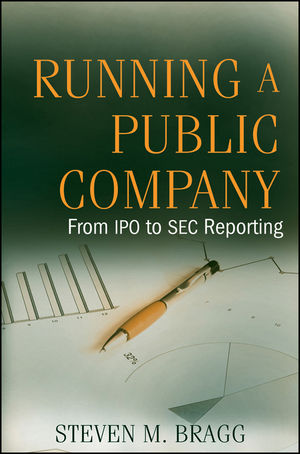Running a Public Company: From IPO to SEC ReportingISBN: 978-0-470-44636-2
Hardcover
September 2009
 This is a Print-on-Demand title. It will be printed specifically to fill your order. Please allow an additional 10-15 days delivery time. The book is not returnable.
|
||||||
Preface.
PART I HOW TO GO PUBLIC.
CHAPTER 1 The Initial Public Offering.
Introduction.
Reasons to Go Public.
Reasons Not to Go Public.
The Cost of an IPO.
Preparing for the IPO.
Finding an Underwriter.
Registering for and Completing the IPO.
Summary.
CHAPTER 2 Acquiring a Public Shell Company.
Introduction.
Pros and Cons of Acquiring a Public Shell Company.
The Mechanics of a Shell Company.
Summary.
CHAPTER 3 Listing on a Stock Exchange.
Introduction.
The Listing Process.
The American Stock Exchange.
The NASDAQ.
Overview.
The NASDAQ Capital Market.
The NASDAQ Global Market.
The New York Stock Exchange.
Comparing the Stock Exchanges.
Summary.
PART II DEALING WITH INVESTORS.
CHAPTER 4 Investor Relations Overview.
Introduction.
Investor Relations Objectives and Goals.
Investor Relations Tools.
The Fact Sheet.
The Press Release.
The Annual Report.
The Annual Meeting.
The Company Web Site.
The Road Show.
The Conference Call.
Float Management.
Summary.
CHAPTER 5 The Investment Community.
Introduction.
The Analyst’s Perspective.
Finding the Right Analyst.
The Sell Side.
Analysts.
Brokers.
Investment Bankers.
Investor Relations Specialists.
The Buy Side.
Types of Investors.
Institutional Investors.
Individual Investors.
Investment Clubs.
Foreign Investors.
Presentations to Investors.
Summary.
CHAPTER 6 Regulation FD (Fair Disclosure).
Introduction.
Policies.
Procedures.
Controls.
Summary.
CHAPTER 7 Stock Repurchases.
Introduction.
Impact on Earnings per Share.
Legal Ramifications.
SEC Reporting.
Adequate Disclosure and Repurchase Instructions.
Impact of Repurchases on Rule 13e-3.
Summary.
PART III DEALING WITH THE SECURITIES AND EXCHANGE COMMISSION.
CHAPTER 8 Registration Statements.
Introduction.
Form S-1.
Form S-3.
Form S-8.
The Shelf Registration.
Declaring a Registration Statement Effective.
Controls.
Summary.
CHAPTER 9 Regulation D (Sale of Unregistered Securities).
Introduction.
Policies.
Procedures.
Controls.
Summary.
CHAPTER 10 Rule 144 (Registration Exemption for Resale of Securities).
Introduction.
Procedures.
Controls.
Summary.
CHAPTER 11 Rule 10b5-1 (Stock Trading Plans).
Introduction.
Policies.
Summary.
CHAPTER 12 Regulation A (Small Issue Exemption).
Introduction.
Policies.
Procedures.
Controls.
Summary.
CHAPTER 13 Fedwire Payments.
Introduction.
Summary.
CHAPTER 14 Form 8-K.
Introduction.
Controls.
Summary.
CHAPTER 15 Insider Securities Ownership and Trading.
Introduction.
SEC Filing Codes.
Short-Swing Profits.
Short Sales by Insiders.
Policies.
Controls.
Summary.
CHAPTER 16 Proxy Solicitations.
Introduction.
Online Proxy Voting.
Policies.
Procedures.
Controls.
Summary.
CHAPTER 17 Regulation M-A (Mergers and Acquisitions).
Introduction.
Policies.
Procedures.
Controls.
Summary.
CHAPTER 18 Private Securities Litigation Reform Act (Forward-Looking Statements).
Introduction.
The Private Securities Litigation Reform Act.
Forward-Looking Statements.
Policies.
Procedures.
Controls.
Summary.
CHAPTER 19 Sarbanes-Oxley Act.
Introduction.
The Public Company Accounting Oversight Board.
Auditor Independence.
Corporate Responsibility.
Enhanced Financial Disclosures.
Analyst Conflicts of Interest.
Other Significant Parts of the Act.
Summary.
Part IV SPECIAL ACCOUNTING STANDARDS FOR A PUBLIC COMPANY.
CHAPTER 20 Interim Reporting.
Introduction.
Example of Interim Reporting of Various Expenses.
Second Example of Interim Reporting of Various Expenses.
Policies.
Procedures.
Controls.
Disclosures.
Summary.
CHAPTER 21 Segment Reporting.
Introduction.
Policies.
Procedures.
Controls.
Disclosures.
Summary.
CHAPTER 22 Earnings per Share.
Introduction.
The Simple Capital Structure.
Example of EPS Computation—Simple Capital Structure.
Preferred Stock Dividends Payable in Common Shares.
The Complex Capital Structure.
Example of the Impact of Contingent Stock Issuances on Earnings per Share.
Examples of EPS Computation—Complex Capital Structure.
Participating Securities and the Two-Class Method.
Example—Participating Convertible Preferred Stock.
Example—Participating Convertible Debt Instrument.
Example—Participating Warrants.
The Effect of Contracts That May Be Settled in Stock or Cash on DEPS.
Inclusions/Exclusions from Computation of DEPS.
The Effect of Contingently Convertible Instruments on DEPS.
Example—Contingently Convertible Debt with a Market Price Trigger.
Effect on EPS of Redemption or Induced Conversion of Preferred Stock.
Earnings per Share Implications of Share-Based Employee Compensation.
Presentation of Earnings per Share.
Controls.
Summary.
CHAPTER 23 Staff Accounting Bulletins.
Introduction.
Selected Staff Accounting Bulletins.
Summary.
CHAPTER 24 Regulation G (Non-GAAP Information).
Introduction.
Policies.
Procedures.
Controls.
Reporting Examples.
Summary.
Part V CLOSING THE BOOKS OF A PUBLIC COMPANY.
CHAPTER 25 Constructing and Filing the Quarterly 10-Q and Annual 10-K Reports.
Introduction.
Constructing the SEC Filing.
Quarterly Auditor Reviews and Audits.
Quarterly Legal Review.
Officer Certification.
Audit Committee Approval.
EDGARizing.
Summary.
CHAPTER 26 Controls for Financial Reporting.
Introduction.
Controls for Financial Reporting.
Summary.
Part VI GOING PRIVATE.
CHAPTER 27 How to Take a Company Private.
Introduction.
The Going Private Transaction.
Rule 13e-3.
Filling Out Schedule 13E-3.
Form 15 304.
The 300 Shareholder Limit.
Summary.
Appendix A Board Questionnaire.
Index.



